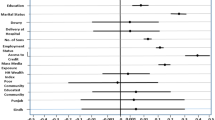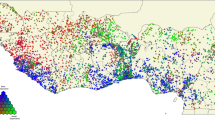Abstract
Various national and international communities have addressed women’s issues and taken various efforts to empower them so as to enhance their social and health status and involve them in developmental activities. The Indian DHS survey (National Family Health Survey, 1998–1999) provides an opportunity to study women’s empowerment in India. The survey collected information on several dimensions of women’s empowerment from 90,303 ever-married women (ages 15–49), from all the states of India. Utilizing these data sets, four indices – household autonomy index, mobility index, attitude towards gender index and attitude towards domestic violence index – are constructed to measure the different dimensions of empowerment. Using these indices, the spatial and socio-economic and cultural disparities that exist within India are analyzed. Finally, an attempt is made to identify some important determinants for women’s empowerment using multiple logistic regression analysis. The results show that at the national level, 43% of the women have high household autonomy; 23% of the women have high freedom to move outside their home; 40% of the women have no gender preference attitude; and only 43% of the women defy domestic violence. But there are significant divergences in these indices of women’s empowerment across the different states and socio-economic and cultural settings within India. Women’s educational levels emerged as an important predictor for all the four dimensions of women’s empowerment. Additionally, media exposure and age have emerged as the important predictors for some dimensions of woman’s empowerment.
Similar content being viewed by others
References
Bardhan K. (1985). Women’s work, welfare and status: forces of tradition and change in India. Economic and Political Weekly 20(51):2261–2267
Batliwala S., 1995: Defining women’s empowerment: a conceptual framework, education for women’s empowerment. In ASPBAE Position Paper for the Fourth World Conference on Women, Beijing, September 1995, New Delhi, Asia-South Pacific Bureau of Adult Education.
G.M. Das (1987) ArticleTitleSelective discrimination against female children in rural Punjab, India Population and Development Review 13 77–100 Occurrence Handle10.2307/1972121
Desai S., Jain D. (1994). Maternal employment and changes in family dynamics: the social context of women’s work in rural South India. Population and Development Review 20(1):115–136
Dixon M.R. (1993). Population Policies and Women’s Rights: Transforming Reproductive Choice. Praeger, Westport, Connecticut
Dyson T., Mick M. (1983). On kinship structure, female autonomy and demographic behaviour in India. Population and Development Review 9(1):35–60
George S., Abel R., Miller B.D. (1998). Female infanticide in rural South India. Search Bulletin July–Sept. 12(3):18–26
Germain A. and Kyte R., 1995: The Cairo consensus: the right agenda for the right time. International Women’s Health Coalition, New York.
Govindasamy P., Malhotra A. (1996). Women’s position and family planning in Egypt. Studies in Family Planning 27(6):328–340
Government of India (GOI), 2001a: Census of India, 2001: Population totals
Government of India (GOI), 2001b: Census of India 2001, Economic tables
Hegde R.S. (1996). Narratives of silence: rethinking gender, agency and power from the communication experiences of battered women in South India. Communication Studies 47:303–317
Heise L., Ellsberg M. and Gottemoeller M., 1998: Ending violence among women. Population reports, Series L, No. 11. JHU school of public health.
Jaisingh I. (1995). Violence against women: the Indian perspective. In: Peters J., Wolper A. (eds). Women’s Rights, Human Rights. Routledge, New York
Jejeebhoy S., 1996: Women’s education fertility and proximate determinants of fertility, Population and women, UN.
Jejeebhoy S., 2000: Women’s autonomy in rural India: Its dimensions, determinants and the influence of context. In Harriet B. Presser and Gita Ser (eds.), Women’s empowerment and demographic processes: moving beyond Cairo, New York, Oxford University Press
Jejeebhoy S., Sathar Z.A. (2001). Women’s autonomy in India and Pakistan: The influence of religion and region. Population and Development Review 27(4):687 –712
Kabeer N., 1998: Money can’t buy me love? Re-evaluating gender, credit and empowerment in rural Bangladesh. IDS Discussion Paper 363.
Kale M., Dayalchand A., Ray C.R., Sen S., Kurian N., Jadhavar (1990). Epidemology of Nutrition: Age and Sex Differentials’, All India Seminar on Status of Women and Demographic Changes in India. IIPS, Mumbai
Karve I. (1965). Kinship Organisation in India, 3rd ed. Rev. Asia Publishing House, Bombay
Kishor S. (2000). Empowerment of women in Egypt and links to the survival and health of their infants. In: Presser H.B., Sen G. (eds). Women’s Empowerment and Demographic Processes. Oxford University Press, New York
Kishor S., Gupta K. (2004). Women’s empowerment in India. In: Rajan I., James K.S. (eds). Demographic Change Health Inequality and Human Development in India. CESS, Hyderabad
Mahmud S., Johnston A.M. (1994). Women’s status, empowerment and reproductive outcomes. In: Sen G., Germain A., Chen L.C. (eds). Population Policies Reconsidered: Health, Empowerment and Rights. Harvard Series on Population and International Health, Boston
Malhotra A, Vanneman, Kishore S. (1995). Fertility, dimensions of patriarchy and development in India. Population and Development Review 21(2):284–300
Malhotra A., Mather M. (1997). Do schooling and work empower women in developing countries? Gender and domestic decisions in Sri Lanka. Sociological Forum 12(4):599–630
Malhotra A., Schuler S.R. and Boender C., 2002: Measuring women’s empowerment as a variable in international development. Un published paper prepared for the World Bank
Mason K., 1998: Wives’ economic decision making power in the family: five asian countries. In The Changing Family in Comparative Perspective: Asia and the United States (pp. 105–133) Ed. Karen Oppenheim Mason, Honolulu, East West Center.
Mason K., Smith H.L. (2000). Husbands’ versus wives fertility goals and use of contraception : the influence of gender context in five asian countries. Demography 37(3):299–311
Mayoux L., 2000: Micro-finance and the empowerment of women: a review of the key issues. International Labor Organization (ILO), Geneva.
MkNelly B. and McCord M., 2001: Credit with education on women’s empowerment impact review No. 1, October 2001.
Moser O.N.C. (1998). Reassessing Urban Poverty Reduction Strategies: The Asset Vulnerability Framework, in World Development, Vol. 26. The World Bank, Washington DC, pp. 1–19
Prasad S. (1999). Medico legal response to violence against women in India. Violence Against Women 5(5):478–506
Schuler S.R. and Hashemi S.M., 1993: Defining and studying empowerment of women: A research note from Bangladesh. In JSI working paper No. 3 Arlington, Virginia.
Sen A. (1990). Gender and cooperative conflicts. In: Tinker I. (eds). Persistent Inequalities: Women and World Development. Oxford University Press, New York
Sen A. (1994). Population policy: authoritarianism versus co-operation. Social change. 24(3–4):20–35
Sopher D.E. (1980). Sex disparity in indian literacy. In: David E. (eds). An Exploration of India: Geographical Perspectives on Society and Culture. Sopher, Logman London
Sample Registration System, 2005: SRS Bulletin, Vol. 39, No. 1, New Delhi, Office of the Registrar.
United Nations, 1995: Population and Development: Programme of Action adopted at the International Conference on Population and Development, Cairo 5–13 September, 1994. Department for Economic and Social Information and Policy Analysis, United Nations.
United Nations, 1995b: Fourth world Conference on Women, Platform for action, women and poverty, Beijing, China – September 1995.
UNFPA, 2005: State of world population 2005, The promise of equality: gender equity, reproductive health and the Millennium Development Goals, UNFPA
Velkoff V.A., 1998: Women’s education in India, Women of the world, International programs center, WID/98–1.
Youssef N.H. (1982). The interrelationship between the division of labour in the household women’s roles and their impact on fertility. In: Anker R., Buvinic M., Youssel N.H. (eds). Women’s Roles and Population Trends in the Third World. Croom Helm, London
Author information
Authors and Affiliations
Corresponding author
Rights and permissions
About this article
Cite this article
Gupta, K., Yesudian, P.P. Evidence of women’s empowerment in India: a study of socio-spatial disparities. GeoJournal 65, 365–380 (2006). https://doi.org/10.1007/s10708-006-7556-z
Issue Date:
DOI: https://doi.org/10.1007/s10708-006-7556-z




